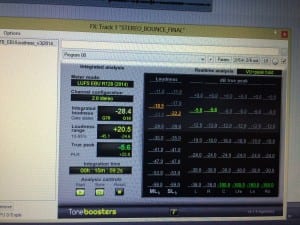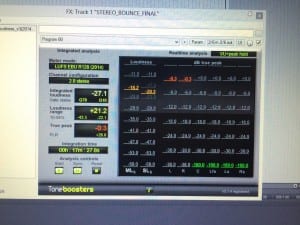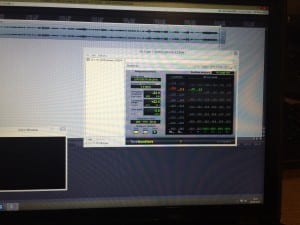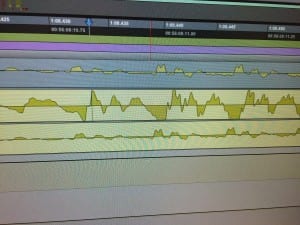(Clickable learning outcomes throughout this post will transfer to a reference list at the bottom)
This post reflects on the successes and failures of the project in detail using my original learning outcomes as signposts.
Our group aim was to manage the process of creating five film soundtracks collectively, and deliver these soundtracks to a good standard and to the client’s specifications. We succeeded in this without any doubt – All of our clients were happy with the work we presented (feedback is available from all of them to this effect), the soundtracks are diverse and of good quality, work synergistically with the pictures, are produced to recognisable technical standards and follow client directions and specifications discerned throughout the project. This evidence also speaks to the achievement of learning outcomes GR3, GR4 and GR5 – all of our clients praised our professionalism on set in their feedback and several noted the quality of music or specific aspects of their film’s audio, and I believe our work in all the distinct audio areas of the films we’ve made is more or less up to scratch.
Only one film slightly lets down the artifact we have delivered in terms of audio quality, and this can largely be put down to the inexperience of the directorial team in choosing horrendously noisy locations and in ignoring our advice about these during recces etc. Beyond this, the raw location audio (which most of us had a hand in at one time or another on set) was also technically flawed in some areas, leading to some issues with dialogue takes in post which couldn’t be rectified to our satisfaction. The film was a dog from the word go, but we did everything in our power to rectify it’s audio problems and if any mistake was made this resides in taking the job in the first place, since there were misgivings from several sides about the script and team.
Addressing group outcomes GR1 and GR2 which are concerned with the internal processes and acting as a company might – I believe we have successfully collaborated as realistically as possible in the sense of a company or partnership in this academic context. Weekly production meetings, a centralised google calendar which was kept up to date with room bookings and workflow plans throughout, supervisors for each film reporting weekly and then daily on their responsibilities and requesting more resources as and when they require them are all testament to this fact.
As a part of the above, I believe I have also fulfilled my more specific research learning outcomes PER1 and PER2, which required me to develop a better understanding of the pros and cons of business structures, processes, regulations and agreements which might enable film audio producers to collaborate on multiple projects and the wording and content of contracts, rates and rate cards offered in the film audio field. We’ve also variously researched and applied many of the fundamental aspects of running a business, with my own focus being on furthering my understanding of the complexities of agreements, contracts and IP in a complicated partnership situation, as well as the more practical aspects of collecting consistent and useful client feedback and structuring data in a way accessible for others who may have to use it – in this last there is much to be learnt from the organisation techniques used in game audio.
The collective process was not without it’s drawbacks however. The administrative burden of managing multiple productions is much greater, and any issue can become a deluge of reorganisation very quickly indeed. The decision to appoint a supervisor for each film also had unexpected ramifications in two ways – the first was the tendency for supervisors to end up isolated with the preproduction ideas and planning processes, which we dealt with through an extra round of regular meetings to read through scripts and collectively input ideas, as well as involving as many of the group as possible in meetings with production teams. The second was the personal investment in what came to be seen as *their* film on the part of some supervisors, which meant that the supervisors tended to want to do the ‘credited’ jobs (such as the dub mix) themselves. Reflecting here, it would have perhaps been more realistic to appoint specialisms on the basis of our research roles within industry, and require that those specialisms fulfill a certain percentage of the work on x number of films within that specialism – for example, I only mixed Descent and some of Remember, to truly represent a dub mixer specialism in my work here I feel I should really have completed at least two full mixes.
Nonetheless, I can certainly say I have fulfilled learning outcome PER4 which required me to contribute extensively to multiple film productions. My contribution – encompassing preproduction input into all of the films, location work on three of them, and significant post production work on Descent, Immort and Remember as well as the ever present administration, ancillary support and meetings – should be evidence enough of this. This blog also provides ample evidence of the management process for Descent, which was arguably the smoothest of all the films until the later post-production phase which required some relatively minor remixing, allowing me to claim learning outcome IN1 as fulfilled. Improvements I would make here were mainly technical – mono mix on location – and, as usual, I would have liked to have had a hand in co-composing the music for the film, but there simply wasn’t time.
The final three learning outcomes IN2, IN3 and PER3 deal with my wish to expand my understanding of techniques deployed in similar works and I have succeeded to my satisfaction in two of these. In learning about and practising mixing to R128 standard I have expanded my knowledge of dub mixing in the post industry, and I have already referred to my contribution to the artifact in that role. My work on the sound design of Immort (street scene and some of the specialist spot FX) and the research which underpin these are evidence of me bettering my understanding of sci-fi sound design.
It is only in PER3 that I would have liked to have done more work. Whilst the study of the film Hannibal is relevant and represents a partial fulfillment of the criteria here, I have had the film Shutter Island sitting next to my DVD player for three months, unwatched. I had intended to draw influence for Descent from this film and present a similar comparative study to that of Hannibal but was unable to find an opportunity to sit down and watch the film.
In final analysis, the intention of the Omni-Gaffer project was to enable us to complete more work more effectively this term and we were fully aware that this would present it’s own unique set of challenges and requirements which I believe we have overcome and fulfilled. I think it’s fair to say the project was successful and justified, since it would not have been possible for this group of students to complete these films – the best part of one hour’s worth of diverse and complex picture – to the standard we have presented whilst working seperately or in smaller groups in my view, but that the extra group size was slightly more useful in the early pre-production and production stages for ideas and spreading the labour intensive production process more evenly, and towards the end as feedback and critical listening became important to drive better quality.
So, for Omni-Gaffer productions it just remains to say thanks for a great degree course and goodnight.
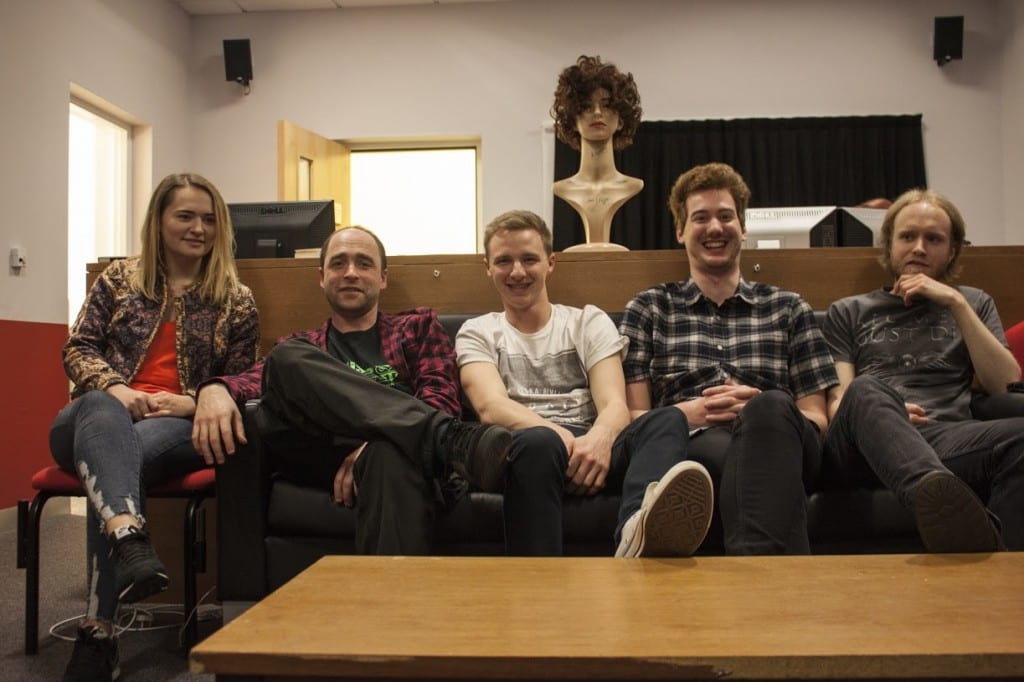
———– 1000 words
——– Learning outcomes, for reference ,
Group Aim
To manage the process of creating the above soundtracks collectively, and to deliver these soundtracks to a good standard and to the client’s specifications.
Group Objectives
- [GR1] To professionally operate as a small to medium size company (or other recognisable business entity) in the audio production / post-production field might.
- [GR2] To organise and fulfil an operating strategy and schedule which deals with multiple productions simultaneously, and which maximises efficiency and minimises issues or risks to delivery.
- [GR3] To provide a professional standard of service in respect to location sound recording and post-sound design / mixing.
- [GR4] To conceive, compose, source and / or produce music to client specifications that synergistically supports the other components of their films.
- [GR5] To produce soundtracks comprising of foley, SFX, dialogue, music and atmospheres to client specifications that synergistically support the other components of their films.
Outcomes and Learning in the context of Moving Picture Industry roles
- [IN1] To successfully manage the provision of service by the business for the film Descent with regard the assignment of resources, specialisms and working time, liason with the director, editor and producer on a practical and creative level, and communication of information on their needs and requirements for the piece, in order to appraise the efficacy of the collaborative approach to working on the piece – (Supervisor and Company Officer)
- [IN2] To develop a better understanding of the craft and industry of a Dubbing Mixer, and to contribute to the dub mixing required for presentation of the artifact – (Dubbing Mixer)
- [IN3] To better my understanding of sound design with at least some reference to the science fiction genre – (Sound Effects Editor)
Personal Learning Outcomes
- [PER1] To develop a better understanding of the pros and cons of business structures, processes, regulations and agreements which might enable film audio producers to collaborate on multiple projects.
- [PER2] To develop a better understanding of the wording and content of contracts, agreements and rate cards offered in the film audio field.
- [PER3] To expand my knowledge of the theory of and audio techniques deployed in films similar to or influential upon those we will deliver.
- [PER4] To contribute extensively to multiple film productions.

